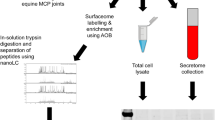Abstract
Cell-ECM (extracellular matrix) interactions are believed to play a key role in maintaining the normal structure of tissues such as cartilage. Cell surface adhesion molecules have been reported to mediate chondrocyte binding to ECM proteins in human normal cartilage but the behaviour of these molecules in human osteoarthritic cartilage is unknown. We studied receptor matrix proteins on freshly isolated chondrocytes obtained from 10 patients with osteoarthritis (OA). Chondrocytes were isolated by enzymatic digestion from three zones of the articular cartilage with a different degree of macroscopic and microscopic damage and chondrocyte phenotype was defined by flow cytometry. Chondrocytes strongly expressedβ 1 integrin but notβ 3 integrin. LFA-1 (CD18/CD11a) and ICAM-1 (CD54) antigens were almost undetectable. Interestingly,β 1 expression was significantly higher in the minimally damaged zone than in the zones with medium and maximum damage. These data show thatβ 1-integrin-mediated chondrocyte-ECM interactions decrease in osteoarthritic cartilage suggesting that perturbations of chondrocyte-matrix signalling occurs during OA.
Similar content being viewed by others
References
Ingber D. Integrins as mechanochemical transducers. Curr Opin Cell Biol 1991;3:841–8.
Damsky CH, Werb Z. Signal transduction by integrin receptors for extracellular matrix: cooperative processing of extracellular information. Curr Opin Cell Biol 1992;4:772–81.
Ginsburg MH, Du X, Plow EF. Inside-out integrin signalling. Curr Opin Cell Biol 1992;4:766–71.
Schlaepfer DD, Hanks SK, Hunter T, van der Geer P. Integrin-mediated signal transduction linked to Ras pathway by GRB2 binding to focal adhesion kinase. Nature 1994;372:786–91.
Poole AR, Billinghurst C, Nelson F. New perspectives in cartilage degeneration in osteoarthritis. Rheumatology in Europe 1995;24(S2):57–65.
Salter DM, Hughes DE, Simpson R, Gardner DL. Integrin expression by human articular chondrocytes. Br J Rheumatol 1992;31:231–4.
Woods VLJ, Schreck PJ, Gesink DS, Pacheco HO, Amiel D, Akeson WH, Lotz M. Integrin expression by human articular chondrocytes. Arthritis Rheum 1994;37:537–44.
Loeser RF, Carlson CS, McGee MP. Expression of beta 1 integrins by cultured articular chondrocytes and in osteoarthritic cartilage. Exp Cell Res 1995;217:248–57.
Springer TA. Adhesion receptor of the immune system. Nature 1990;346:425–34.
Marlin SD, Springer TA. Purified intercellular adhesion molecule-1 (ICAM-1) is a ligand for lymphocyte function-associated antigen 1 (LFA-1). Cell 1987;51:813–9.
McCourt PA, Ek B, Forsberg N, Gustafson S. Intercellular adhesion molecule-1 is a cell surface receptor for hyaluronan. J Biol Chem 1994;269:30081–4.
Miyauchi A, Alverez J, Greenfield EM, Teti A, Grano M, Colucci S, et al. Recognition of osteopontin and related peptides by an alpha v beta 3 integrin stimulates immediate cell signals on osteoclasts. J Biol Chem 1991;266:20369–74.
Helfrich MH, Nesbitt SA, Dorey EL, Horton MA. Rat osteoclasts adhere to a wide range of RGD (Arg-Gly-Asp) peptide-containing proteins, including the bone sialoproteins and fibronectin, via a beta 3 integrin. J Bone Miner Res 1992;7:335–43.
Toole BP. Hyaluronan and its binding proteins, the hyaladherins. Curr Opin Cell Biol 1990;2:839–44.
Laurent TC, Laurent UB, Fraser JR. Functions of hyaluronan. Ann Rheum Dis 1995;54:429–32.
Knudson CB. Hyaluronan receptor-directed assembly of chondrocyte pericellular matrix. J Cell Biol 1993;120:825–34.
Hua Q, Knudson CB, Knudson W. Internalization of hyaluronan by chondrocytes occurs via receptor-mediated endocytosis. J Cell Sci 1993;106:365–75.
Mankin HJ, Dorfman H, Lippiello L, Zarins A, Biochemical and metabolic abnormalities in articular cartilage from osteo-arthritic human hips. II. Correlation of morphology with biochemical and metabolic data. J Bone Joint Surg 1971;53A:523–37.
Lapadula G, Iannone F, Zuccaro C, Covelli M, Patella V, Lobianco G, Pipitone V. Expression of membrane-bound peptidases (CD10 and CD26) on human articular chondrocytes. Possible role of neuropeptidases in the pathogenesis of osteoarthritis. Clin Exp Rheumatol 1995;13:143–8.
Erlacher L, Maier R, Ullrich R, Kiener H, Aringer M, Menschik M, Graninger W. Differential expression of the protoncogene bel-2 in normal and ostheoarthritic human articular cartilage. J Rheumatol 1995;22:926–31.
Durr J, Goodman S, Potocnik A, von der Mark H, von der Mark K. Localization of beta 1-integrins in human cartilage and their role in chondrocyte adhesion to collagen and fibronectin. Exp Cell Res 1993;207:235–44.
Loeser RF. Integrin-mediated attachment of articular chondrocytes to extracellular matrix proteins. Arthritis Rheum 1993;36:1103–10.
Dalton SL, Marcantonio EE, Assoian RK. Cell attachment controls fibronectin and alpha 5 beta 1 integrin levels in fibroblasts. Implications for anchorage-dependent and-independent growth. J Biol Chem 1992;267:8186–91.
Donahue HJ, Guilak F, Vander Molen MA, Mcleod KJ, Rubin CT, Grande DA, Brink PR. Chondrocytes isolated form mature articular cartilage retain the capacity to form functional gap junctions. J Bone Miner Res 1995;10:1359–64.
Davies ME, Dingle JT, Pigott R, Power C, Sharma H. Expression of intercellular adhesion molecule 1 (ICAM-1) on human articular cartilage chondrocytes. Connect Tissue Res 1991;26:207–16.
Jobanputra P, Corrigall V, Kingsley G, Panayi G. Cellular responses to human chondrocytes: absence of allogeneic responses in the presence of HLA-DR and ICAM-1. Clin Exp Immunol 1992;90:336–44.
Author information
Authors and Affiliations
Corresponding author
Rights and permissions
About this article
Cite this article
Lapadula, G., Iannone, F., Zuccaro, C. et al. Chondrocyte phenotyping in human osteoarthritis. Clin Rheumatol 17, 99–104 (1998). https://doi.org/10.1007/BF01452253
Received:
Accepted:
Issue Date:
DOI: https://doi.org/10.1007/BF01452253




